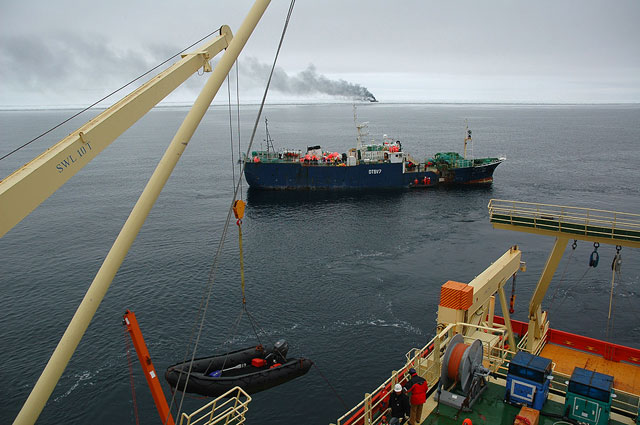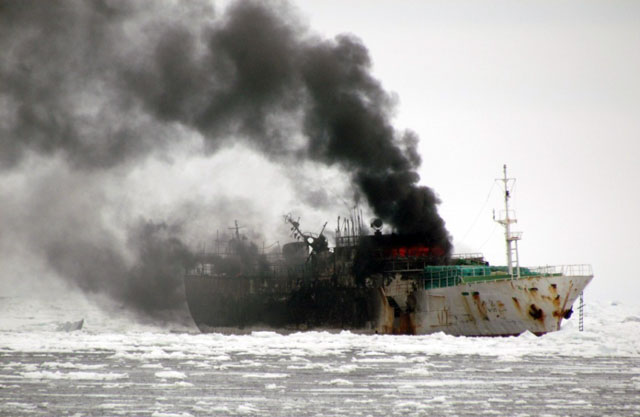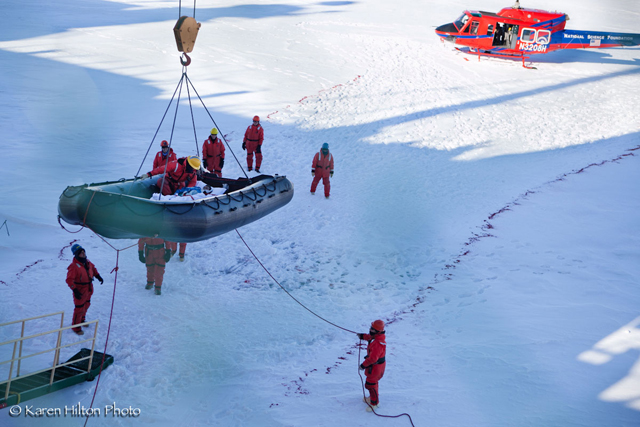To the rescueUSAP research vessel transports victims of ship fire to safetyPosted January 23, 2012
It only took about 10 minutes for the research vessel Nathaniel B. Palmer A South Korean fishing vessel, Jeong Woo # 2, had caught fire, and the crew was abandoning ship. The Palmer, one of two research vessels for the U.S. Antarctic Program (USAP) “We had science happening. We had instruments over the stern, and so we immediately pulled them out of the water and steamed over to the position given to us by the New Zealand Rescue Coordination Center,” said Al Hickey, marine projects coordinator for Raytheon Polar Services “We were fortunate that the weather conditions were ideal. Great visibility, very little wind, so the seas were down, which made our transit very, very easy,” Hickey added. Information from the Rescue Coordination Center of New Zealand (RCCNZ) On the other hand, the Palmer had a well-provisioned hospital with four berths. Two EMTs were also aboard. Dan Powers works as a senior marine technician, while Lindsey Ekern is a senior marine science technician for the research cruise. Most of the time they deal with clinical questions and minor first aid problems that can occur at all hours of the day, according to Hicky. These duties are in addition to their primary ship responsibilities. “We were extremely fortunate to have two very competent EMTs,” he said. By 7 p.m. that same day, the smoke from the burning ship could be seen 11 miles out. More than half of the white-hulled ship was charcoal black. Dark smoke billowed huge plumes into the air, and flames leapt out of portholes where the glass had blown out. “It was very sobering. It was incredibly sobering. We didn’t know what to expect,” Hickey said. “We were initially prepared for an unknown number of survivors, before getting word prior to arrival that we would be receiving seven patients.” There were forty crewmembers aboard the Jeong Woo # 2 when it caught fire. Three were missing and presumed dead. All 37 of the survivors had been brought aboard the sister ship, the Jeong Woo # 3, awaiting the arrival of the Palmer. The Palmer made contact with the Jeong Woo #3, communicating in Russian between a member of the fishing vessel and the Palmer’s ice pilot, Vladimir Repin, according to Hickey. It took less than an hour to transfer the seven injured men — four Vietnamese and three Indonesians — to the Palmer by small inflatable boats called Zodiacs. Four of the injured were able to climb aboard the ship using a Jacob’s ladder, while the other men were each lifted in the Zodiac by crane, with an attendant, onto the Palmer’s helicopter deck, which is on the same level as the ship’s hospital. One of the scientists aboard the Palmer, Hai Doan, is Vietnamese and was able to communicate with the injured men. Doan and two other grantees volunteered to help in the hospital while the Palmer made its way to McMurdo Station, nearly 400 miles away. Meanwhile, the USAP’s Emergency Operations Center (EOC) at McMurdo Station 
Photo Credit: ©Karen Hilton
The Palmer at the sea ice edge where it dropped off the fishing vessel victims to McMurdo Station personnel.
Less than 36 hours later, after picking its way through pack ice for the final 10 hours, the Palmer reached the edge of the frozen sea ice, about 16 miles from McMurdo Station, shortly before 5 a.m. on Jan. 12. The EOC team in McMurdo arranged for helicopters from the research facility to land nearby, and all seven men were eventually airlifted to a nearby airfield. A ski-equipped LC-130, operated by the New York Air National Guard Meanwhile, after all the injured crew had been transferred, the Palmer pulled away from the ice edge and returned to its science mission in support of a project to study how iron, a key nutrient in phytoplankton growth, cycles through the Southern Ocean. “I would like to acknowledge the tremendous cooperation from everybody,” Hickey said, adding that everyone aboard volunteered to help. “It was good to have that kind of atmosphere trying to pull something like this together,” he said. “Working with [McMurdo] and RCCNZ was seamless. When the helicopters arrived with the medical staff, who were with us by phone during this entire medevac, it felt like the cavalry had arrived. We thank everybody … for their help. So many people played a vital role.”
|



For USAP Participants |
For The Public |
For Researchers and EducatorsContact UsU.S. National Science FoundationOffice of Polar Programs Geosciences Directorate 2415 Eisenhower Avenue, Suite W7100 Alexandria, VA 22314 Sign up for the NSF Office of Polar Programs newsletter and events. Feedback Form |




